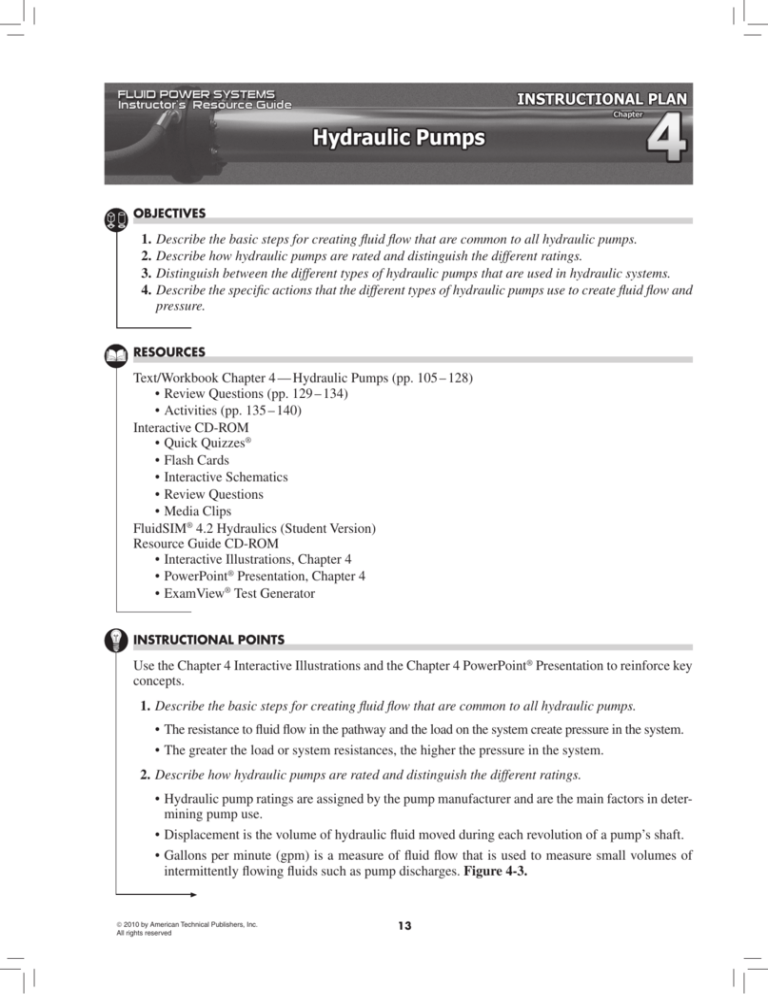
OBJECTIVES
1.
2.
3.
4.
Describe the basic steps for creating fluid flow that are common to all hydraulic pumps.
Describe how hydraulic pumps are rated and distinguish the different ratings.
Distinguish between the different types of hydraulic pumps that are used in hydraulic systems.
Describe the specific actions that the different types of hydraulic pumps use to create fluid flow and
pressure.
RESOURCES
Text/Workbook Chapter 4 — Hydraulic Pumps (pp. 105 – 128)
• Review Questions (pp. 129 – 134)
• Activities (pp. 135 – 140)
Interactive CD-ROM
• Quick Quizzes®
• Flash Cards
• Interactive Schematics
• Review Questions
• Media Clips
FluidSIM® 4.2 Hydraulics (Student Version)
Resource Guide CD-ROM
• Interactive Illustrations, Chapter 4
• PowerPoint® Presentation, Chapter 4
• ExamView® Test Generator
INSTRUCTIONAL POINTS
Use the Chapter 4 Interactive Illustrations and the Chapter 4 PowerPoint® Presentation to reinforce key
concepts.
1. Describe the basic steps for creating fluid flow that are common to all hydraulic pumps.
• The resistance to fluid flow in the pathway and the load on the system create pressure in the system.
• The greater the load or system resistances, the higher the pressure in the system.
2. Describe how hydraulic pumps are rated and distinguish the different ratings.
• Hydraulic pump ratings are assigned by the pump manufacturer and are the main factors in determining pump use.
• Displacement is the volume of hydraulic fluid moved during each revolution of a pump’s shaft.
• Gallons per minute (gpm) is a measure of fluid flow that is used to measure small volumes of
intermittently flowing fluids such as pump discharges. Figure 4-3.
© 2010 by American Technical Publishers, Inc.
All rights reserved
13
14
Fluid Power Systems Instructor’s Resource Guide
• Pressure rating is the highest amount of pressure at which a pump can create flow against.
• Volumetric efficiency is the relationship between actual and theoretical fluid flow, or pump gpm.
Figure 4-4.
3. Distinguish between the different types of hydraulic pumps that are used in hydraulic systems.
• A positive-displacement pump is a pump that has a positive seal between its inlet and outlet and
moves a specific volume of hydraulic oil with each revolution of the shaft. Figure 4-5.
• A fixed-displacement pump is a positive-displacement pump where the fluid flow rate (gpm) cannot be changed. Figure 4-6.
• A variable-displacement pump is a positive-displacement pump that can have its flow rate (gpm)
changed. Figure 4-7.
4. Describe the specific actions that the different types of hydraulic pumps use to create fluid flow and
pressure.
• A gear pump is a hydraulic pump that consists of gears that mesh together in various manners to
create fluid flow. Figure 4-9.
• An external gear pump is a gear pump that consists of two externally toothed gears that form a
seal within the pump housing. Figure 4-10.
• A lobe pump is a positive-displacement pump that has two external-driven, intermeshing, lobeshaped gears. A lobe pump operates similar to an external gear pump. Figure 4-11.
• An internal gear pump is a gear pump that consists of a small external drive gear mounted inside
a large internal spur gear, (ring gear). The two gears rotate in the same direction. Figure 4-12.
• A gerotor pump is a gear pump that has an inner rotor that meshes with the gear teeth of an outer
rotor. Figure 4-13.
• A vane pump is a hydraulic pump that creates a vacuum by rotating a rotor inside a cam ring while
trapping fluid between vanes that expand and retract from the rotor while moving the fluid toward
the output. Figure 4-15.
• An unbalanced vane pump is a fixed- or variable-displacement hydraulic pump in which the pumping action occurs in the chambers on one side of the rotor and shaft. Figure 4-16.
• A variable-displacement, pressure-compensated, vane pump is a pump that automatically adjusts
the amount of volume it displaces per rotation by centering the rotor when the pressure in the
system starts to build. Figure 4-17.
• A balanced vane pump is a pump that consists of a cam ring, rotor, vanes, and a port plate with
opposing inlet and outlet ports. Figure 4-18.
• A piston pump is a hydraulic pump in which fluid flow is produced by reciprocating pistons.
• An axial piston pump is a piston pump that consists of pistons in a rotating piston block parallel
to the drive shaft. Axial piston pumps create smooth fluid flow for piston pumps. Figure 4-21.
• A variable-displacement piston pump is a piston pump in which the angle of the swash plate can be
varied. Figure 4-22.
• A bent-axis piston pump is a piston pump in which the pistons and cylinders are at an angle to the
drive shaft and thrust plate. Figure 4-23.
• A radial piston pump is a piston pump that consists of a cylinder barrel, pistons with shoes, a ring,
© 2010 by American Technical Publishers, Inc.
All rights reserved
Instructional Plan Chapter 4 — Hydraulic Pumps
15
and a valve block located perpendicular to the pump shaft. Figure 4-24.
• Hydraulic pumps are available with double and triple pump styles. These pump styles have two
or three pumping units inside a single pump housing on the same shaft. Figure 4-26.
REVIEW
Review chapter objectives, summarizing the information presented.
Have learners review content using the following:
• Chapter 4 Review Questions (pp. 129 – 134 or Interactive CD-ROM)
• Chapter 4 Activities (pp. 135 – 140)
• Quick Quiz®: Chapter 4
• Interactive Schematic: Hydraulic Stamping Press
• Flash Cards: Chapter 4
• Media Clips: Positive-Displacement Pump Operation; External Gear Pump Operation; Lobe Pump
Operation; Internal Gear Pump Operation; Unbalanced Vane Pump Operation; Cavitation
Review answers with learners.
EVALUATION
Have learners complete the following:
• Chapter 4 Test (from ExamView® Test Generator)
Review answers with learners.
Evaluate mastery of each objective required.
© 2010 by American Technical Publishers, Inc.
All rights reserved








